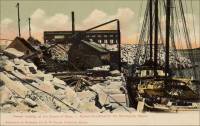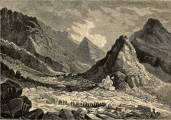


Quarries in Maine & Quarry Links, Photographs, and
Articles
(Continued)
- South Berwick, York County, Maine – the Hanscom Granite Quarry (Walker Ledge) (light gray color) Structures in which this stone was used include: Berwick Academy in Berwick, Maine; and for curbing - locations not stated. (For a more detailed description of granite and location of quarry, see Maine Quarries and Prospects published by the Maine Geological Survey, written by M. B. Austin and A. M. Huseey, II, John R. Rand, State Geologist, May 1, 1958, pp. 16.)
- South Berwick, York County, Maine - the Miniutti Black Granite Quarry (very dark olive, brownish color) The stone from this quarry was used for monuments - locations not stated. (For a more detailed description of the granite and location of quarry, see Maine Quarries and Prospects published by the Maine Geological Survey, written by M. B. Austin and A. M. Huseey, II, John R. Rand, State Geologist, May 1, 1958, pp. 21.)
- South Berwick, York County, Maine - the Spence & Coombs Black Granite Quarry (Perry openings) (very dark olive-greenish color) Stone from this quarry was used for monuments - locations not stated. (For a more detailed description of the granite and location of quarry, see Maine Quarries and Prospects published by the Maine Geological Survey, written by John R. Rand, State Geologist, May 1, 1958, pp. 28.)
- South Berwick, York County, Maine (also listed in Wells, York County, Maine) - the Swenson Pink Granite Quarry (High Pine Quarry; Bald Hill Quarry) Structures from this stone include: the Gardiner Savings Bank in Gardiner, Maine; the Livermore Falls Trust Co. in Livermore Falls, Maine; Tiffany and DePinna Stores in New York City; Seagrams Building in New York City; the Pentagon building in Washington, C. C.; the Statler Hotel in Washington, D. C.; the States Mutual Life Assurance Company in Worcester, Massachusetts; the Department of Water Supply building in Detroit, Michigan; the Mellon Memorial Fountain in Washington, D. C.; and crushed stone and riprap and split face veneer - locations not stated. (For a more detailed description of granite and location of quarry, see Maine Quarries and Prospects published by the Maine Geological Survey, written by M. B. Austin and A. M. Huseey, II, John R. Rand, State Geologist, May 1, 1958, pp. 29.)
- South Brooksville, Hancock County, Maine - the Bucks Harbor
Quarries, from The Commercial Granites of New England, Bulletin
738, by T. Nelson Dale, U. S. Geological Survey, 1923.
These quarries were located “at Bucks Harbor, South Brooksville.” The operator was the John T. Brady & Co., 103 Park Avenue, New York. Granite from an opening one-half mile southeast of South Brooksville was reportedly a light grayish-buff color with conspicuous black mica and a coarse to medium texture. From another opening one-fourth mile northeast of South Brooksville was reportedly a medium-gray color with conspicuous black mica and a coarse texture.
Minerals in descending order of abundance: a light cream-colored potash feldspar (microcline and orthoclase), smoky quartz, a milk-white soda-lime feldspar (oligoclase), and black mica (biotite), with accessory magnetite.
The quarries had two openings: “one lying half a mile southeast of the village (Brooksville)” and the other “one-fourth mile northeast of the village (Brooksville.)” The first opening measured 200 feet by 100 feet with a depth from 5 to 20 feet in 1905 and the other opening in 1905 measured about 200 by 100 feet with a depth from 5 to 10 feet. Transport of the granite was to two granite wharves owned by the company, which afforded 12 feet of water at low tide. In 1917 the quarries were idle.
- South Portland, Maine – Ballantine & Morin (Monument
Dealer) (Excerpts from “Motor Truck in the Monument
Business: What Retail Monument Dealers Think of the Efficiency of Motor
Transportation for Memorial Work,” article in Granite Marble & Bronze,
Vol. XXXI, No. 1, January 1921, pp. 32-33d.
“A short time ago Granite Marble & Bronze sent out a questionnaire to thousands of retail monument dealers throughout the country for information regarding the part the motor truck plays in the retail monument business….”
“Of course, the real interest in connection with this digest is in quoting what the dealers have to say about the subject, for the sayings are many and various….”
“Ballantine & Morin, South Portland, Me.:
“‘We believe the motor truck has been a great time-saver in the monument business. With our truck we can handle double the work we handled with a team.’”
- South Thomaston, Knox County, Maine - the Bassick Granite Quarry (medium gray) (For a more detailed description of granite and location of quarry, see Maine Quarries and Prospects published by the Maine Geological Survey, written by M. B. Austin and A. M. Huseey, II, John R. Rand, State Geologist, May 1, 1958, pp. 7.)
- South Thomaston, Maine - The Sprucehead Quarry (Sprucehead Island), from The Commercial Granites of New England, Bulletin 738, by T. Nelson Dale, U. S. Geological Survey, 1923.
-
This quarry was located "on Sprucehead Island, in the town of South Thomaston, about 10 miles south of Rockland." The owner was the Bodwell Granite Co. of Rockland, Maine. When the quarry was measured in 1905 it was about 275 feet by 250 feet. It had a maximum depth of 55 feet and an average depth of about 27 feet. The rock from the quarry, "Sprucehead," was reportedly "conspicuous black, white, and gray particles" with a medium to course texture. Transport of the rock was by cart 300 feet to the wharf. The quarry had not been used since 1910 at the time of the report.
The rock from the Sprucehead Quarry was used in the following examples: the Carnegie Library in Allegheny, Pennsylvania; the post office and customhouse in Atlanta, Georgia; the columns of the Auditorium Building in Chicago, Illinois, the Mutual Life Insurance Co.'s building and the National City Bank in New York; and the exterior of the post office in Bar Harbor, Maine.
- South Thomaston, Knox County, Maine - the Sprucehead Granite Quarry. Structures from this quarry include: the Carnegie Library in Allegheny, Pennsylvania; the Custom House in Atlanta Georgia; the Post Office in Atlanta, Georgia; the Post Office in Bar Harbor, Maine; the Mutual Life Insurance Co. building in New York City; and the Columns for the auditorium building in Chicago, Illinois. (For a more detailed description of the granite and location of quarry, see Maine Quarries and Prospects published by the Maine Geological Survey, written by M. B. Austin and A. M. Huseey, II, John R. Rand, State Geologist, May 1, 1958, pp. 28.)
- South Thomaston, Maine - the Weskeag Quarry, from
The Commercial Granites of New England, Bulletin 738, by T. Nelson
Dale, U. S. Geological Survey, 1923.
This quarry was "in the town of South Thomaston, 1 mile west of Pleasant Beach and 7 miles south of Rockland." The granite from the quarry was reportedly a slightly bluish medium gray color with a medium to coarse texture. In 1905 the quarry measured about an acre of ground and had an average depth of 20 feet. Transport of the granite was by cars and horsepower on a track half a mile to the wharf near Birch Point. At the time of the report, the quarry had not been used since 1914.
- South Thomaston, Knox County, Maine - the Weskeag Granite Quarry (medium gray color) (For a more detailed description of the granite and location of quarry, see Maine Quarries and Prospects published by the Maine Geological Survey, written by M. B. Austin and A. M. Huseey, II, John R. Rand, State Geologist, May 1, 1958, pp. 30.)
- Spruce Island, Maine - the Stonington Quarry (part of the Stonington
District), from The Commercial Granites of New England, Bulletin
738, by T. Nelson Dale, U. S. Geological Survey, 1923.
This quarry was "on the west shore of Spruce Island, 3 1/4 miles east-southeast of Stonington." The granite in the quarry was reportedly a pinkish-buff color. Some of the pinkish-buff granite was rimmed with a cream-colored granite.
The Stonington Quarry was opened in 1905, although at the time of the report it was abandoned.
- St. George, Maine - the Clark Island Quarry (Clark
Island), from The Commercial Granites of New England, Bulletin 738,
by T. Nelson Dale, U. S. Geological Survey, 1923.
This quarry was "on Clark Island, in the town of St. George, about 12 miles south-southwest of Rockland." The owner was the Rodgers Granite Corporation, 271 West 125th Street in New York. The granite from the quarry was reportedly a bluish-medium gray with a fine to medium texture.
The Clark Island Quarry opened about 1870. In 1905 the quarry measured 500 by 300 feet and had a maximum depth of 50 feet and an average depth of 25 feet. Transport of the granite was by horse power on a track 900 to 1,200 feet to the wharf.
Granite from the Clark Island Quarry was used in the following examples: the post offices in Hartford, Connecticut, and Buffalo, New York; and the Standard Oil Building in New York.
- St. George, Knox County, Maine - the Clark Island
Granite Quarry (bluish medium gray color) Structures in
which this stone was used include: the Post Office in Buffalo, New
York; the Post Office in Hartford, Connecticut; the Standard Oil Building
in New York City, New York; and the Drydock in Norfolk, Virginia.
(For a more detailed description of granite and location of quarry, see
Maine Quarries and Prospects published by the Maine Geological
Survey, written by
M. B. Austin and A. M. Huseey, II,
John R. Rand, State Geologist, May 1, 1958, pp.
12.)
- Clark’s Island Granite Co. - Bill of Prices For Cutting Granite For Clark's Island, Long Cove, and Vicinity, (Book) Clark's Island Granite Company, Rockland, Maine, Opinion Steam Job Print, 1881-83, 16 pp. (Copy located in the Degolyer Library Collection in the “Trade Catalogs” section. Degolyer Library, Southern Methodist University, Dallas, Texas.) [PDF]
- St. George, Knox County, Maine - the Flat Ledge Granite Quarry (dark gray color) Stone from this quarry was used for paving - locations not stated. (For a more detailed description of granite and location of quarry, see Maine Quarries and Prospects published by the Maine Geological Survey, written by John R. Rand, State Geologist, May 1, 1958, pp. 14, presented on the Maine Quarry Preservation web site.)
- St. George, Knox County, Maine - the Hocking Granite Quarry (gray color) Structures in which this stone was used include: Van Wyck Expressway Bridge in Idlewild, Long Island, New York; Curbing around fountain and driveway of United Nations building in New York City, New York; Approach to Brooklyn Battery Bridge in New York City; First National Bank in Lewiston, Maine; and in curbing. (For a more detailed description of the granite and location of quarry, see Maine Quarries and Prospects published by the Maine Geological Survey, written by M. B. Austin and A. M. Huseey, II, John R. Rand, State Geologist, May 1, 1958, pp. 17.)
- St. George, Maine – the Long Cove Granite Quarry (From Stone: An Illustrated Magazine, Vol. XII, No. 1, December, 1895, “Notes From Quarry and Shop” section, Stone Publishing Co., New York, pp. 74.)
“The Long Cove granite quarry, St. George, Me., owned and operated by the Booth Bros. and Hurricane Isle Granite Company, was the scene of a gigantic blasting event, November 4. During the past few years rock in this quarry available for the cutters became scarce, and in casting about for a means to overcome the difficulty, Mr. Booth, one of the New York members of the concern, hit upon the scheme of excavating into the immense wall which forms the eastern end of the quarry, and by a single mine explosion to provide granite sufficient to last many months. Since December last (1894) there has been drilling into the mountain a tunnel fifty-six feet long, with arms thirty-six and thirty feet long. In this tunnel cells were constructed for the explosives. The work of building the tunnel was delayed by the foul air, for a match would not burn a few feet inside the entrance. The loading of the cells occupied two days. Five hundred and fifty kegs of powder and four tons of dynamite were placed in total darkness, for to use a light meant too many chances against the lives of the workmen. Charles Shuler, of Graniteville, Mo., an expert in big granite blasting, superintended the blasts. Scores of conspicuous granite men from New York, Philadelphia, Chicago, and St. Louis, and 5,000 persons from all parts of Knox county gathered on the hillsides. Mounted men closed all avenues of approach and warned all persons within a quarter of a mile to seek safety. James Smith, son of the superintendent of the Hurricane quarry, pressed an electric button and a puff of smoke was followed by the lifting, high in air, of the huge bluff. One hundred thousand tons of the finest granite had been exposed, and crevices 200 feet long and 3 feet wide were seen in every direction. The shock was tremendous in one direction, but hardly perceptible toward Rockland. The explosion cost $3,000.”
- St. George, Maine - the Long Cove Quarry, from The
Commercial Granites of New England, Bulletin 738, by T. Nelson Dale,
U. S. Geological Survey, 1923.
This quarry was located "near both Tenants Harbor and Long Cove, in the township of St. George, about 13 miles southwest of Rockland." The operator was Booth Bros. & Hurricane Isle Granite Co., 208 Broadway, New York. Granite from the quarry was reportedly a medium-gray color with a fine to medium texture similar to the granite found at the Clark Island Quarry. Transport of the granite was by inclined track 900 feet to the wharf.
The Long Cove Quarry was opened about 1873. In 1905 the quarry measured about 1,000 feet north to south by 500 feet east to west and had a depth from 20 to 75 feet, averaging about 40 feet in depth. "This is the only quarry in New England in which tunneling is resorted to in the use of explosives."
Granite from the Long Cove Quarry was used mainly for monuments and was sent mainly to Greenwood and other cemeteries near Brooklyn, New York. Paving blocks were also made. Granite from this quarry was used in the following examples: the post office in Albany, New York; the Bates Building in Philadelphia; and part of the Saratoga monument.
- St. George, Knox County, Maine - the Long Cove Granite Quarry (medium gray color) Structures in which this stone was used include: Post Office in Albany, New York; and Bates Building in Philadelphia, Pennsylvania. (For a more detailed description of the granite and location of quarry, see Maine Quarries and Prospects published by the Maine Geological Survey, written by M. B. Austin and A. M. Huseey, II, John R. Rand, State Geologist, May 1, 1958, pp. 19.)
- St. George, Maine - The McConchie Quarry, from The
Commercial Granites of New England, Bulletin 738, by T. Nelson Dale,
U. S. Geological Survey, 1923.
This quarry was "in the town of St. George, about three-fourths mile north of Long Cove quarry." The granite from the quarry, "Crown Black Granite," was reportedly a very dark gray shade with a fine to medium texture. The granite was "carried 10 miles to the cutting works at South Thomaston, although the quarry itself is within one-fourth mile of seaboard."
The McConchie Quarry opened in 1888. In 1905 the quarry measured about 50 feet square and had a depth from 10 to 15 feet. At the time of the report, the quarry was idle.
Granite from the McConchie Quarry was used in the Soldiers' monuments at Warren and Union, Maine.
- St. George, Knox County, Maine - the McConchie Black Granite Quarry (Norite with magnetite of very dark shade) Structures in which this stone was used include: Soldiers Monument in Union, Maine, and Soldiers Monument in Warren, Maine. (For a more detailed description of the granite and location of quarry, see Maine Quarries and Prospects published by the Maine Geological Survey, written by M. B. Austin and A. M. Huseey, II, John R. Rand, State Geologist, May 1, 1958, pp. 20.)
- St. George, Maine - The Willards Point or Wildcat Quarry,
from The Commercial Granites of New England, Bulletin 738, by T.
Nelson Dale, U. S. Geological Survey, 1923.
This quarry was "on Tenants Harbor, in the township of St. George, about a mile south of the Long Cove quarry." The operator was the St. George Granite Co., 90 West Street, New York. Granite from the quarry was reportedly similar to that found in Long Cove and Clark Island Quarries, which was reportedly a medium-gray color with a fine to medium texture. The quarry was 30 feet from the dock.
The Rockland post office was made from granite from the Willards Point or Wildcat Quarry, although at the time of the report, the granite was used entirely for paving.
- St. George, Knox County, Maine - the Wildcat Granite Quarry (Willards Point). Stone from this quarry was used in the Post Office in Rockland, Maine and for paving - locations not stated. (For a more detailed description of the granite and location of quarry, see Maine Quarries and Prospects published by the Maine Geological Survey, written by M. B. Austin and A. M. Huseey, II, John R. Rand, State Geologist, May 1, 1958, pp. 31.)
- St. Helena Island, Maine - the St. Helena Quarry (part of the
Stonington District), from The Commercial Granites of New
England, Bulletin 738, by T. Nelson Dale, U. S. Geological Survey,
1923.
This quarry was "on St. Helena Island.2 miles southeast of Stonington." The operator was Benisch Bros., 895 Jamaica Avenue, Brooklyn, New York. The granite in the quarry was reportedly a pinkish-buff color with a coarse texture. At the time of the report, the St. Helena Quarry was idle. By the time of the 1923 report, the quarry had been idle since 1917.
The Marine Wireless Operators' monument in New York, was built using granite from this quarry.
- Stoneham, Maine -
the Lord Hill Quarry (photograph), presented by the Maine
Geological Survey.
- Stoneham, Maine - the Lord Hill Quarry (photograph), presented by Quarry Adventures.
- Stonington, Maine – Granite Shipments ca. 1902 (The following information is from the section “Marble and Granite” in Stone: An Illustrated Magazine Devoted to Stone, Marble, Granite, Slate, Cement, Contracting and Building, Vol. XXIV, No. 1, January, 1902, Stone Publishing Co., New York , pp. 61.)
Stonington, Maine, Granite Shipments
A large amount of rough stone is being shipped from the quarries at Stonington, Me., this winter. Two or more boatloads are sent nearly every week from the Settlement quarry, while it is a common occurrence to see three or four large vessels waiting for a chance to load at the Crotch Island quarries.
- Stonington, Hancock County, Maine - the St. Helena Island Granite Quarry (lavender pink color) Stone from this quarry was used in the Marina wireless operators monument in New York City. (For a more detailed description of the granite and location of quarry, see Maine Quarries and Prospects published by the Maine Geological Survey, written by M. B. Austin and A. M. Huseey, II, John R. Rand, State Geologist, May 1, 1958, pp. 26.)
- Stonington, Maine - Map Showing Location of Quarries about Stonington, Me.
-
(Reduced from Deer Isle Shett, Topographic Atlas U. S., U. S. Geol. Survey.) Fig. 15 (From The Granites of Maine, Bulletin 313, 1907.){insert text here}
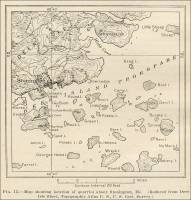
- Stonington District, Maine - "The granite industry which centers in Stonington is distributed over an area of about 4 miles square.Some of the quarries are on Deer Isle, others are south of it, on Crotch Island, so named from the inlet which divides it, and the rest are on neighboring islets..The Stonington quarries embrace several varieties of granite." (From The Commercial Granites of New England, 1923.)
- Stonington, Maine - A Granite Quarry
-
(colorized postcard photograph #84677; published in Germany for G. W. Morris, Portland, Maine; unmailed, early 1900s)
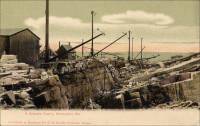
- Stonington, Hancock County, Maine - the Benvenue Granite Quarry (pink) This stone was used for buildings and monuments - locations not stated. (For a more detailed description of granite and location of quarry, see Maine Quarries and Prospects published by the Maine Geological Survey, written by M. B. Austin and A. M. Huseey, II, John R. Rand, State Geologist, May 1, 1958, pp. 8.)
- Stonington, Hancock County, Maine - the Merrill Granite Quarry (lavender-gray color) Stone from this quarry was used in the State Office Building in Augusta, Maine. (For a more detailed description of the granite and location of quarry, see Maine Quarries and Prospects published by the Maine Geological Survey, written by M. B. Austin and A. M. Huseey, II, John R. Rand, State Geologist, May 1, 1958, pp. 21.)
- Stonington, Maine - Granite Quarry, Stonington, Me.
-
Granite Quarry, Stonington, Maine (colorized postcard photograph; published in Germany for G. W. Morris, Portland, Maine; postmark 1906.)
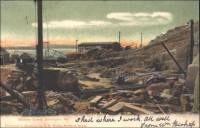
- Stonington, Maine - Quarry of Ryan - Parker Construction Co., Stonington Maine. Vessel loading at the quarry of Ryan - Parker Construction Co.
-
-
Stonington, Maine – the Ryan Parker Construction Company Quarry (from The Monumental News, Vol. XIX, No. 2, February 1907, pp. 169)
The Largest Sheet of Granite in the World
“From the quarry of the Ryan Parker Construction Co., at Crotch Island, Me., has been freed what is considered the largest sheet of stone in the world. The actual dimensions of same are 250 feet long, 30 feet deep, with an average width of 50 feet. It contains 375,000 cubic feet, which estimated at the rate of 10 cubic feet to the ton contains 37,500 tons. By a series of lewises starting at the top and running out to as narrow a point as possible, which required but little channeling at the bottom, very little expense was entailed in freeing this enormous body of stone. There has already been knocked off, from the bottom, one cut of the sheet, from which there has been furnished for a large vault job in New York two roof stones which are 22 feet long by 11 feet wide, and a 1 foot 4 inch rise.”
- Stonington, Maine – Settlement Quarry, Island Heritage Trust, Stonington, Maine, 1996. (The link from which the following information was obtained is no longer available.)
<http://www.monroassociates.com/projects%20Parks_&_recreation.htm>The Settlement Quarry was one of the projects of Monro Associates, of Portland, Maine. Monro Associations "flagged trails and developed illustrations for fundraising depicting potential interpretive and recreational uses of an historic quarry. Trails were also a part of the design."
- Stonington, Hancock County, Maine - the Stonington Granite Quarries (pinkish buff color) (For a more detailed description of the granite and location of quarry, see Maine Quarries and Prospects published by the Maine Geological Survey, written by M. B. Austin and A. M. Huseey, II, John R. Rand, State Geologist, May 1, 1958, pp. 29.)
- Stonington, Hancock County, Maine - the Stonington Granite Quarry (lavender, medium gray color & pinkish buff gray color) (For a more detailed description of the granite and location of quarry, see Maine Quarries and Prospects published by the Maine Geological Survey, written by John R. Rand, State Geologist, May 1, 1958, pp. 26.)
- Stow, Maine at Deerhill - Eastman Gem Quarry and Associated Area (photographs). History of Intergalactic Mining involvement at the Eastman Quarry and associated area, Maine, presented by Intergalactic Mining. (Also see Dennis Creaser's web site, "Creaser Jewelers" to see some of the jewelry created from the stones from this area.)
| “View of the largest sheet of granite in the world. Crotch Island, Maine.” (Ryan Parker Construction Co. quarry) (from The Monumental News, Feb. 1907, pp. 169) | 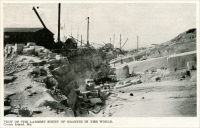 |
Commercial use of material within this site is strictly prohibited. It is not to be captured, reworked, and placed inside another web site ©. All rights reserved. Peggy B. and George (Pat) Perazzo.
